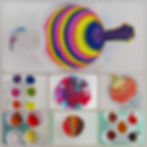Paint Consistency for Acrylic Pouring
- Laura Longoni
- Dec 9, 2023
- 3 min read
Updated: Mar 5

The most difficult challenge in acrylic pouring is to find the right paint consistency according to the pouring technique we want to use.
As a general rule you can effect the paint consistency as follows: if you want thinner consistencies, you need to add more pouring medium or water; if you want thicker consistencies, you have to add more paint.
On YouTube every artist has developed its own recipe to create the right consistency for its paintings but sometimes what works for an artist doesn't work automatically for all because there can be differences due to the used pouring medium (water, floetrol, glue, Liquitex Pouring medium, etc.) or the used acrylics (heavy body, soft-body or high-flow).
In my case, for example, I don't use neither floetrol nor water or a combination of both. Instead I prefer a ready-to-use pouring medium and tend to observe the consistency of my mixed paints rather than using a formula to calculate how many parts of paint or pouring medium I need.
A good method to understand the consistency of our paints is to observe the speed at which our mixed paints falls from our mixing spoon into our mixing cup (so-called trace) and how fast the little "mountain" it creates on the surface of the mixed paint (so-called mould) will be incorporated in the paint: the faster the trace falls and the mould is incorporated the thinner our mixed paint is.
Here a little consistency overview.
Paint Consistency for Acrylic Pouring: an overview
Thin Consistency
Paint/Pouring Medium Mixing Ratio
In thin consistencies the amount of pouring medium is bigger than the amount of paint (for example 1 part paint + 3 pouring medium) . If you use water to thin your acrylics, keep in mind that water needs less time to thin the paint compared to pouring medium and it is advisable to add water very slowly until you get the right consistency.
By thin consistency the mould usually takes less than 1 second to completely sink in the paint.
Pouring Techniques' Suitability
This kind of consistencies are suitable for following techniques: Dutch pour, cloud pour, pearl pour, balloon kiss, cell activator.
Pro/Contra
Thin consistencies are easy to mix and they can form more easily grays and neutral colours when tilting the canvas.
Medium Consistency
Paint/Pouring Medium Mixing Ratio
In medium consistencies the amount of pouring medium is the double of the amount of paint (for example 1 part paint + 2 pouring medium) . If you use water to thin your acrylics, keep in mind that water needs less time to thin the paint compared to pouring medium and it is advisable to add water very slowly until you get the right consistency.
By medium consistency the mould usually takes about 1 second to completely sink in the paint.
Pouring Techniques' Suitability
This kind of consistencies are good for following techniques: straight pour, dirty pour, swipe, open cup, funnel pour, bottle bottom, string/chain pull, kiss pour, puddle pour, feather pour.
Pro/Contra
Medium consistencies are easier to control. They can mantain their original hues limiting the creation of grays and neutral colours when tilting the canvas.
Thick Consistency
Paint/Pouring Medium Mixing Ratio
In thick consistencies we increase the amount of paint leaving the amount of pouring medium constant (for example 2 parts paint + 3 parts pouring medium or 3 parts paint + 3 parts pouring medium). If you use water to thin your acrylics, keep in mind that water needs less time to thin the paint compared to pouring medium and it is advisable to add water very slowly until you get the right consistency.
By thick consistencies the mould usually takes 2-3 seconds to completely sink in the paint.
Pouring Techniques' Suitability
This kind of consistencies are good for following techniques: flip cup, ring pour, bloom, swipe with cell activator, blob painting.
Pro/Contra
Medium consistencies are easier to control. They can mantain their original hues limiting the creation of grays and neutral colours when tilting the canvas.
A Thickness Test: the Drip Test.
If you are not sure about the consistency of your mixed paint, another instrument is the so-called "Drip Test". To make this test you will need a surface such as a piece of wood or a thick piece of paper and, after putting a small amount of your mixed paint on it and inclining this surface, you will determine the thickness by observing the speed at which it flows down: the faster the mixed paint flows, the thinner it is. (Useful tutorial: https://www.youtube.com/watch?v=24_dH7y9btQ )
I hope I could help you to better understand how the paint consistency works and to improve your paintings.
Thank you for reading. If you like the post, leave a like, a comment and don't forget to follow my blog and Instagram and share the content on your social media.
Have a colourful day!
Laura